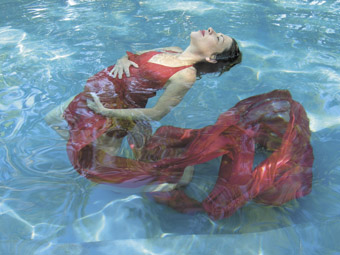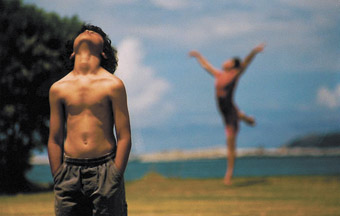crossing the divide
karen pearlman at the new york dance on camera festival

Rapt
THE NEW YORK DANCE ON CAMERA FESTIVAL IS ONE OF THE OLDEST CONTINUOUSLY RUNNING DANCE FILM FESTIVALS IN THE WORLD. AS SUCH, IT HAS HAD ENORMOUS INFLUENCE OVER THE DEVELOPMENT OF THE FORM: PROVIDING AN EXHIBITION SPACE, A PORTAL TO THE WORLD, A FORUM FOR CREATIVITY FROM TIMES WHEN DANCE ON SCREEN WAS BARELY EVEN KNOWN TO EXIST, THROUGH TO ITS CURRENT BOOM IN THE CONSCIOUSNESS OF DANCE CULTURE.
The Artistic Director of Dance on Camera, Deirdre Towers, bristles a bit when she hears people talk about dance on camera as ‘new form.’ It is a newer form than dance, but it is as old as cinema, older than contemporary dance, and much, much older than the ‘brat pack’ currently energising and expanding screendance creation and exhibition.
In fact, for Towers, dance on camera is not a new form but at least two old forms—and she struggles to straddle the divide in audiences and aesthetics for these two versions. To put it colloquially, there is an ‘uptown’ form and a ‘downtown’ form of dance on screen, and the venues for the New York Dance on Camera Festival play out and play on this divide. The festival is supported by the Lincoln Center Film Society, so one of its major screening venues is the Walter Reade Theater at Lincoln Center, a distinctly uptown venue with a 300 seat cinema, a 35mm projector, ushers and a popcorn vendor that also sells cappuccinos and ginger pistachio tarts. The regular crowd for this venue expects to see one of two things: documentaries about dance, preferably about famous dancers or choreographers, but possibly some ethnographically unusual mix, or dancefilms by firmly established names, Mark Morris, William Forsythe and Gene Kelly, for example, all of whom featured on this year’s calendar.
The other, the ‘downtown’ form of dance on screen is what we would call here the ‘independent’, but I hate this name because it implicitly creates a divide in legitimacy along the lines of infrastructure rather than approach. The other tags, ‘new’ or ‘experimental’ are also inaccurate: it is neither new nor experimental. The creation of a dancing screen—a screen work that emanates from a choreographic sensibility and combines the available manipulations of time, movement and energy in dance with those in cinema—is not new. It just wavers a bit in and out of cultural consciousness, and in so doing loses its history and knowledge base. Therefore it is also not experimental because the creative artists rarely test their ‘experiments’ against a stable control group or against documented knowledge or theories. What it is, this other form of dance on screen, is a working through of the possibilities of cinematic and choreographic properties towards the realisation of an image or idea. The subjects of these creations are not external, as they are in documentary—the films are not about something but are themselves the subject, they are dances in light and sound.
So, being old and venerable, and presenting both documentaries on dance and dances in light and sound creates some very interesting problems and equally intriguing possibilities for the Dance on Camera Festival. Towers and the new festival coordinator, Anna Brady Nuse, came up with some excellent lateral strategies for reaching each of their audiences, pushing perceptions of the form to cross out of their comfort zones and still allowing the festival to break even. Their energy and openness were rewarded with huge media coverage (the festival made regular appearances in the pages of the New York Times, the New Yorker, et al), strong audience attendance and a thought provoking festival.
One of Towers’ strategies was to open a third venue and present work under the title “Program devoted to dance narratives.” This screening was at the Maya Deren Theatre in Anthology Film Archives, which is downtown, yes, but it has proper seats and a 35mm projector, too. The program featured the 54-minute film I produced and edited, Thursday’s Fictions (directed and choreographed by Richard James Allen), which was my excuse for attending the festival, and two narrative shorts—Flying Days by Pablo Diconca and Another by Helena Jonsdottir. All three are works on screen that live in the space between dance and cinema to create what we at The Physical TV Company call “stories told by the body.” The audience that filled the house seemed to come from uptown and from downtown for this kind of experience, which plays with conventions to reach across the divide between character-driven drama and abstract movement to make a truly kinaesthetic cinema.

Break
Other festival strategies for pushing audiences across the divide included programming dance made for the screen as shorts preceding documentaries about dance, and presenting a rigorously curated evening of international shorts in the uptown venue. Two films from our region, Sue Healy’s Will Time Tell and Shona McCullagh’s Break, the festival Jury Prize winner, were on this program which, together with Thursday’s Fictions, made Australia/New Zealand a very well represented region. Surprising as it may seem to us, as we struggle for funding and screenings, the world thinks there is a lot happening down here in dance on screen and that it is leading stuff. The region’s representation at this festival certainly demonstrated that, especially when compared to some of the work I saw from the US.
The American Shorts program on the closing night of the festival was not just a strategy to include the ‘downtown’ in the festival, though it was held at a venue so far ‘downtown’ that it is was in Brooklyn, in a converted warehouse performance space with a gallery, a bar and a lived-in grunge that made me feel right at home. It was also a strategy to boost American production and visibility in a field dominated by Britain, Europe and Australia/New Zealand. I wanted the films on this program to prove Towers wrong when she said the history of dance on film is a history of men and technology and women in nature. Maybe it was just coincidence, but in the program, films that used technology—digital effects toys—were by men and the productions set in nature—trees, sunsets, water—were by women. None was especially well developed but the festival is acting in a catalytic capacity by creating this new program, hoping to stimulate the thinking and production values in its home country.
Also designed to stimulate thinking and production were the two free panels held in conjunction with the festival. There was “Meet the Producers”, where the powerhouses of dance on screen production from Britain (Portland Green of Capture) and Canada (Judy Gladstone of Bravo!FACT), talked about their organisations’ impact on dance on screen in a session moderated by newcomer Hélène Lesterlin, the curator in charge of a new American dancefilm commissioning fund, DANCE MOViES, at the Experimental Media & Performing Arts Center (EMPAC). And there was “From Cutting a Rug to the Cutting Room”, a panel moderated by Special Projects coordinator, Kelly Hargraves, which brought together three dancers who work professionally as editors—not just of dance films, but of all kinds of things—Monica Gillette (Sopranos, Law & Order, Progressive Coma), Robbie Shaw (Bittersweet) and myself. Or were we editors who dance? Either way, the sense that editing is a form of choreography came out with overwhelming force. We all agreed we work the edits through our dancers’ kinaesthetic intelligence—and it is in the edit suite where the two arts, cinema and dance, whether documentary or the other, cross the divide and both begin to dance.
35th Annual Dance on Screen Festival, New York, Jan 3-14
RealTime issue #78 April-May 2007 pg. 31






